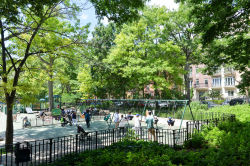Washington Skate Park
Terrapin Playground
This playground honors the terrapin, a common name for any freshwater turtle, but specifically referring to the diamondback species, native to marshes in eastern North America. Terrapins thrive in brackish water and are the only turtles native to North America that can survive in water where salinity levels are close to that of the ocean. The diamondback terrapin, the most common one, often exhibits a great deal of physical variation in terms of shell pattern, skin color, and markings, even within the same population. They are identified by their deeply grooved, diamond-shaped scutes, or bony shell plates, from which their name derives. For years, terrapins were hunted for their meat, which is considered a delicacy. Consequentially, the terrapin faced extinction until several states acted to protect them, and the market for their meat dwindled. Today, they are hunted on a small scale, but face more immediate dangers from commercial development and roads encroaching on their territory.
Terrapin Playground is located in the Park Slope neighborhood of Brooklyn. The neighborhood derives its name from its proximity to Prospect Park and the gradual topographical incline from the Gowanus Canal to the park. First inhabited by the Canarsie Indians, the area now known as Park Slope was colonized by Dutch farmers in the 1660s. During the Revolutionary War (1775-1783) the area became the site of a brief, explosive moment, in what is known as the Battle of Brooklyn, or the Battle of Long Island. On August 27, 1776, an outnumbered American regiment faced approximately 4,000 British soldiers at Battle Pass, a point now contained within Prospect Park.
In the 1870s, horse-drawn rail carts leading to the park lured well to do New Yorkers to its urbanized, but peaceful streets. Railroad businessman and lawyer Edwin Clarke Litchfield (1815-1885), whose villa off Prospect Park West now serves as the headquarters of Parks in Brooklyn, had purchased huge tracts of farmland in the 1850s and began selling them to home developers after the Civil War. Prospect Park, designed by Frederick Law Olmsted and Calvert Vaux in 1865, developed into an oasis at the end of the 19th century as people scrambled to build mansions along Prospect Park West, which was known as the “gold coast.” In South Slope, by the Gowanus Canal, a growing Italian and Irish population worked along the waterfront and lived in more modest row houses. Today, Park Slope is famous for its tranquil, tree-lined streets and remarkably intact row houses, stately brownstones, and Queen Anne, Renaissance Revival, and Romanesque mansions. A revitalization movement began in the 1960s and 1970s, and residents today make beautifying and enriching their community a top priority. With a strong artist community and a lively history, Park Slope is one of the most culturally rich neighborhoods in the city, host to numerous parades, fairs, and outdoor markets.
The land for Terrapin Playground was acquired by the City in 1948 by private purchase and condemnation, and the playground opened in 1951 as J.H.S. 51 Playground because of the adjacent school (now called William Alexander M.S. 51). The playground is jointly operated by Parks and the Board of Education. It contains basketball and handball courts, a baseball field, drinking fountains, and benches. In 1997, the park was renamed by Commissioner Stern to honor one of the area’s most venerable inhabitants.
Check out your park's Vital Signs
Clean & Safe
Green & Resilient
Empowered & Engaged Users
Share your feedback or learn more about how this park is part of a
Vital Park System











